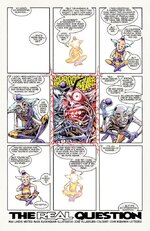[T]he
Ascension [
section] participates in innumerable ways in a Jewish apocalyptic ascent framework, while the
Martyrdom section is deeply enmeshed with the Ascension. The christological features thus seem to have developed within that framework—not through precise editorial additions but as part of a [Jewish] “continuous religious subculture,” as I described in a 2003 article, in which
features we now call Christian came about as part of apocalyptic speculation and composition. What we see in
Ascension of Isaiah, then, is a moment in evolution, Jewish but with interests in Christ. [
David Frankfurter, "Beyond 'Jewish Christianity': Continuing Religious Sub-Cultures of the Second and Third Centuries and Their Documents." In The Ways That Never Parted: Jews and Christians in Late Antiquity and the Early Middle Ages, edited by Adam H. Becker and Annette Yoshiko Reed (Tübingen: Mohr Siebeck, 2003), 131-43.]
[...]
Now, as much as this is the kind of fictional narrative that situates apocalyptic visions, it also remarkably captures a sort of
shamanic séance performance as documented cross-culturally: (a) the preparation of the séance and its participants, both adept shamans and lay audience; (b) ritual—liturgical—stages that bring heightened experience; followed by ( c) the possession/ascension of various experts in the group; and (4) their subsequent disclosures (here actually inscribed: 6:16-17), which may have particular value for the community and its beliefs. I.M. Lewis would call this a “main-morality possession cult.”
Let me add parenthetically here that I do prefer the term “shaman” to “prophet” on descriptive grounds, since “prophet”/
navi is really an “emic” (or insiders’) term, lending traditional authority to a religious role. Certainly,
Ascension of Isaiah embraces this traditional designation throughout the text. Also, I should say that shamanism, as a religious phenomenon, admits a great fluidity between possession
by spirits, ascent
accompanied by spirits, instruction
from spirits, and so on. Christian exegetes tend to make weighty distinctions between possession and encounter that would not have made sense to the ancient insider. There were multiple ways to describe similar experiences with supernatural beings.
Ascension of Isaiah, then, seems to reflect an original
Sitz-im-Leben in such a shamanic setting. I owe my realization of this setting to Robert Hall and Enrico Norelli, who both picked up on this witness to first-century prophetic guilds back in the early 1990s. [4] But where their interest lay in the scribal features of these prophetic guilds—Hall going as far as calling them “schools”—mine remain in their performative features. And this is where the Book of Revelation belongs in the discussion. For John of Patmos testifies that he too was “in the spirit on the Lord’s Day,” which indicates a possession state brought on by collective liturgical performance. And he too encounters a divine spirit—the anthropomorphic figure we might call the Lord-Angel—before he ascends to heaven in chapter 4. In the realm of possession, especially, Revelation is quite fluid: John alternately speaks to and is inhabited by the Lord-Angel throughout the text (esp. chaps. 1, 22).
The texts are clearly independent, but each comes from a prophetic/shamanic milieu steeped in Jewish apocalyptic tradition. And each seeks to orient that tradition, among other things, to revelations of Jesus’s heavenly nature, whether
before birth (as in
Ascension of Isaiah) or after death (as in Revelation). In neither case is it helpful historically, textually, or religiously to classify them as “Christian,” since their Christ-interests are idiosyncratic—indeed, many would say, oriented more towards the perpetuation of the Jewish apocalyptic tradition itself than any sort of participation in a broader “Christian” institution.

